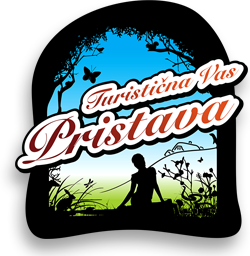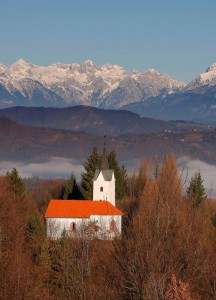Welcome to Pristava!
A good half-hour drive in the south-eastern direction from the capital city of Slovenia will bring you to the Lower Carniola region. If you leave the motorway at Ivančna Gorica and drive towards the town centre and then among the meadows towards the Stična Monastery, you will arrive directly at Pristava by following the road that passes the Primary school. At the Pristava Tourist Village, we can serve you a range of food and beverages by prior appointment. The meal is served in a forest clearing or in our multi-purpose picnic area.
The name “Pristava” or marof comes from the German Meierhof, which means “manor house”. The word was meant to denote a house or a smaller castle with outbuildings and land that belonged to the manor. There was indeed a hunting castle in this area during the lifetime of Viridis Visconti in the 14th century, which most probably contributed to the name of our village.
Today, the castle at Pristava is no longer standing; however, the Church of St. Lambert still lies on the hill. St. Lambert was an educated 7th century missionary. He travelled around the world and managed conditions within the Church, which were poor back then.
The small village, where the 4 farms are located, is also known for its memorials, which are important for the inhabitants of Slovenia.
The “Lady from Pristava”, the famous Dutchess Viridis Visconti from Milano who lived here in the 14th century, is certainly one of the most illustrious inhabitants. Her coat of arms, which depicts a serpent swallowing a child, is currently used by the Alfa Romeo car brand name from Milano. Viridis was one of the children of Bernabò Visconti and Beatrice Regina della Scala, who also went down in history as the wife of Leopold III, Duke of Austria and the patron of the Stična Monastery. She spent the final years of her life at Pristava nad Stično.
One of the other important monuments at Pristava is the Partizanski dom (the Partisan Hut). It was built in 1963 with the help of volunteers. The land on which it stands once belonged to the Pr Tonijevih farm. The family donated part of their land to enable its construction. The Partizanski dom was built both as a sanctuary for the fighters and a memorial to the fallen. The volunteer workers, who laboured tirelessly to build the Partizanski dom, had lunch prepared by Cveta from the Pr Tonijevih farm. Even back then, she really knew how to cook.
The housewife at the farm began running a food establishment at Partizanski dom. She bred hens and chicks at home. Naturally, she also bought chickens from the neighbouring farms since her fried chicken was very popular. Chickens bred at Pristava and in its surroundings were free range and spent their time on the meadows. She cooked beef and Vienna soup. Her Vienna soup contained the following ingredients: roasted onions, beef, potatoes, marjoram, garlic, cumin and paprika. Fried chicken was synonymous with Pristava cuisine. Naturally, it was accompanied by fried potatoes, which were not so well-known back then. It graced the plates of gentry. The menu also included veal chops in sauce with fried potatoes or rice and buckwheat mush (žganci) with stew. During the autumn, when people gathered produce from their gardens and bell peppers were plentiful, Cveta bought prime meat at the butcher’s in Stična and prepared stuffed bell peppers. Dessert included the ever present apple strudel and a type of cake with a home-made marmalade filling.
Near the Partizanski dom, there is a monument dedicated to the fallen activists from Upper Carniola. The hut also has a memorial plaque commemorating the important role played by Pristava during World War II skirmishes. On 18 November 1964, Partizanski dom was visited by Josip Broz Tito who is remembered by many as a good leader and an honourable man.
In 1990, a secret battle plan was adopted at Pristava with the goal of defending Slovenia. The basic ideas behind it were carried out in the July 1991 Slovenian Independence War.
The important memorial sites also include the Pristava roundabout and the coat of arms depicting a serpent swallowing a child – the symbol of the Metnaj local community. The coat of arms was cast in Livarna, the Ivančna Gorica foundry.
Pristava attained its contemporary feel by unifying the farms and bolstering their cooperation. Today, we present ourselves under the name Pristava Tourist Village. We strive for self-sufficiency and try to offer exclusively home-grown food.
The photographs below show Pristava from a few decades ago.
We cordially invite all visitors to the Pristava Tourist Village website to send in any photographs showing the beauty of Pristava nad Stično if they happen to have them. This will enable us to show the history of Pristava nad Stično through photographs.
The postcards are the property of the Slovene Museum of Christianity and the collectors Zvone Lavrič and Marjan Potokar. We would like to thank them for sending them to us.


















